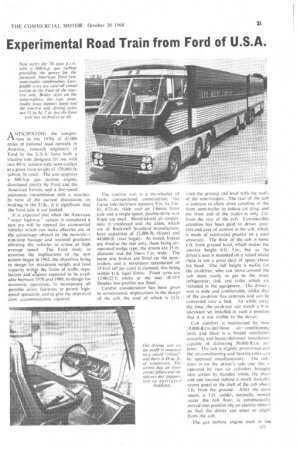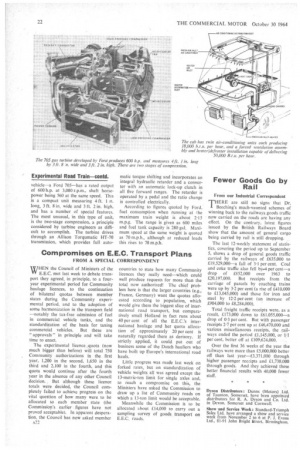Experimental Road Train from Ford of U.S.A.
Page 23

Page 24

If you've noticed an error in this article please click here to report it so we can fix it.
NTICIPATING the convict-I tion in the 1970s of 41,000 miles of national road network in America, research engineers of Ford in the U.S.A. have built a tractive unit designed for use with two 40-ft. tandem-axle semi-trailers at a gross train weight of 170,000 lb. (about 76 tons). The unit employs a 600-h.p. gas turbine engine, developed jointly by Ford and the American Forces, and a five-speed automatic transmission with a retarder. In view of the current discussions on braking in the U.K., it is significant that the front axle is not braked.
It is expected that when the American "super highway' system is completed a new era will be opened for commercial vehicles which can make effective use of the advantages offered by the network— non-stop haulage and minimal gradients allowing the vehicles to cruise at high average speed. The Ford study to examine the implications of the new system began in 1962, the objectives being to design for maximum weight and load capacity within the limits of traffic regulations and engines expected to be available between 1970 and 1980; to design for economic operation; to incorporate all possible safety features: to permit highspeed operation, and to give the improved crew accommodation required.
The tractive unit is a six-wheeler of fairly conventional construction; the frame side-members measure 9 in. by 3 in. by 0.25 in. thick and an 1-beam front axle and a single-speed, double-drive rear bogie are used. Hendrickson air suspension is employed and the axles, which are of Rockwell Standard manufacture, have capacities of 12,000 lb. (front) and 44,000 lb. (rear bogie). As stated, brakes are fitted at the rear only, these being airoperated wedge type; the drums are 15 in. diameter and the liners 7 in. wide. The same size brakes are fitted on the semitrailers and a maximum retardation of 15 ft/s2 (47 per cent) is claimed, this being within U.S. legal limits. Front tyres are 12-00-22-5, whilst at the rear 18-19-5 Duplex low-profiles are fitted.
Careful consideration has been given to aerodynatnid implications in the design of the cab, the roof of which is 13 ft.
from the ground and level with the roofs of the semi-trailers. The rear of the cab is concave to allow close coupling of the front semi-trailer to reduce air drag, and the front end of the trailer is only 2 ft. from the rear of the cab. Considerable attention has been paid to driver comfort and ease of control in the cab, which is made of reinforced plastics on a steel structure. The floor of the cab is some 6 ft. from ground level, which makes the interior height 6 ft. .3 in., but as the driver's seat is mounted on a raised island there is not a great deal of space above his head. The full height is useful for the co-driver, who can move around the cab more easily to get to the oven. refrigerator, sink and toilet which are included in the equipment. The driver's scat is wide and comfortable, whilst that of the co-driver has armrests and can be converted into a bed. To while away the time, the co-driver can watch a 9-in. television set installed in such a position that it is not visible to the driver.
Cab comfort is maintained by twin I 8,000-13.t.u.-per-hour air conditioning units and there is a forced ventilation assembly and heater/defroster installation capable of delivering 50,000 B.Lit. per hour. The cab is slightly pressurized and the air-conditioning and heating units can be operated simultaneously. The onl:, door is on the driver's side and this is operated by two air cylinders brought into action by handles inside the door and one located behind a small, lockable access panel in the shell of the cab about 5 ft. from the ground. After the door opens, a 5-ft. ladder,normally stowed under the cab floor, is automatically moved into position (by an electric motor) so that the driver can enter or alight from the cab.
The gas turbine engine used in the vehicle—a Ford 705—has a rated output of 600 h.p. at 3,080 r.p.m., shaft horsepower being 560 at the same speed. This is a compact unit measuring 4 ft. 1 in. long, 3 ft. 8 in. wide and 3 ft. 2 in. high, and has a number of special features. The most unusual, in this type of unit, is the two-stage compression, a principle considered by turbine engineers as difficult to accomplish. The turbine drives through an Allison Torqumatic HT-70 transmission, which provides full auto matic torque shifting and incorporates an integral hydraulic retarder and a converter with an automatic lock-up clutch in all five forward ranges. The retarder is operated by a pedal and the ratio change is controlled electrically.
According to figures quoted by Ford, fuel consumption when running at the maximum train weight is about 2-15 m.p.g. The range is given as 600 miles and fuel tank capacity is 280 gal. Maximum speed at the same weight is quoted as 70 m.p.h., although at reduced loads this rises to 78 m.p.h.












































































































